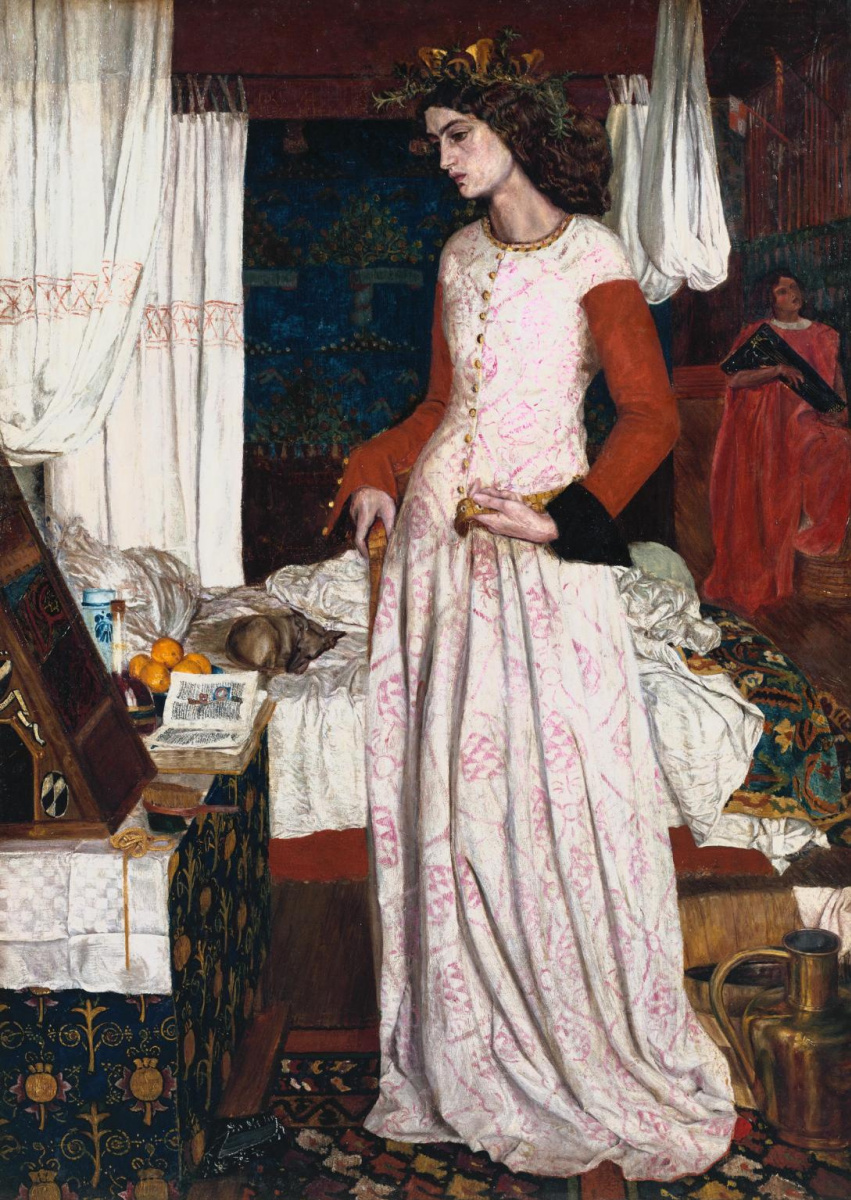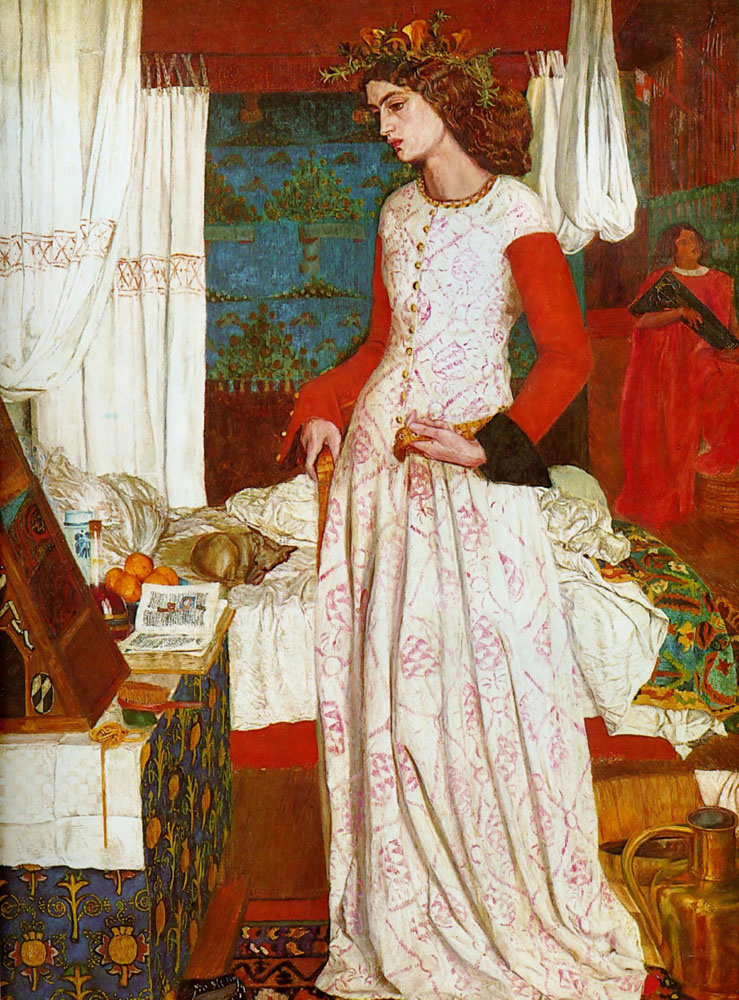log in
Enter site
Login to use Arthive functionality to the maximum
Beautiful Isolde (Portrait of the Artist's Wife Jane Morris)
William Morris • Painting, 1858, 71.8×50.2 cm
Description of the artwork «Beautiful Isolde (Portrait of the Artist's Wife Jane Morris)»
"Beautiful Isolde" - this is the only painting by William Morris, which depicts his future wife Jane Bearden in 1858.
Jane in a medieval dress is in the image of Isolde, longing for the expelled Tristan. Initially, the researchers believed that this is the repentant queen of Guinevere, the wife of King Arthur, who betrayed him with the beautiful knight Lancelot. This version contributed to the publication of Morris's poetic work "Protection of Guinevere and other poems" in the year of writing the picture. But later it was established that this is Isolde, the legendary beloved of Tristan.
Isolde seemed to just get out of bed - in crumpled white sheets you can see a puppy of an English hound. Perhaps the girl in love did not close her eyes at all - her face was pale and tired. The branches of rosemary, denoting fidelity, are woven into a wreath and speak eloquently about Isolde's thoughts and feelings, she is true, but not to her husband. White dress with a delicate pattern falls to the floor, completely hiding the body, but while emphasizing the curves of the figure. Bright red sleeves contrast with the general pallor and dullness of Isolde, but at the same time perfectly fit into the overall situation of the castle room. The heroine with a careless hand holds the golden belt - a symbol of chastity, which she wants to tighten on the hips, as it was fashionable in the Middle Ages.
Details and their meaning
Cloth more like a decorative work than painting. Clear graphics, local colors and increased emphasis on detail - all this speaks of the author's desire for decor, design and folk art. Red, blue, white and golden shades give the composition a carnival, bright mood. Color shades show traditional national motifs, and details are the author's personal passions: old books, mirrors, Persian carpets, snow-white curtains, wall decoration and even shiny copper jugs. Most likely all these items were from the collection of Morris and were written from nature. The drawing on the wall and the decor of Isolde's dressing table repeats the prints used by the artist in the work of his company.
Alison Smith, a member of the Tate Gallery, notes that "The Beautiful Isolde" is one of several works of Pre-Raphaelites created under the influence of Jan Van Eyck's painting. Such details as a dog, oranges, shoes on the floor and even the pose of the heroine resemble the famous portrait of the four Arnolfini.
Over the picture, William Morris worked for several months, it was given to him rather difficult. The desire to create a real painting work and fight against one's own preferences complicated his work.
Hardly giving himself the image of the heroine: Morris has already fallen in love with his future wife. In the future, he will practically not write it, only a few sketches remain in the legacy. There is a legend, as if in vain attempts to achieve anatomical accuracy, on the back of the picture he wrote: "I can not write you, but I love you".
Like the Queen of Guinevere, so Isolde are women, the heroines of the glorious English epic, who experienced deep feelings, but not to their husbands. Morris' love for Jane Burden, despite the fact that she became his wife, brought him much pain and disappointment. Later, Jane and does admit that she never loved her husband.
Perhaps, this is not the best painting work among pre-Raphaelite artists, but it is quite accurate that it is deeply conscious, felt and is to some extent prophetic.
In 1874 the picture was declared a property Ford Madox Brown, however, she wanted to redeem Rossetti, passionately fond of his wife Morris. In the end, the painting went to Rossetti's son. Until his death, it was stored in a forgotten cupboard and only after Jane was returned. In 1939, according to her will, the painting became the property of the Tate Gallery.
Author: Lyudmila Lebedeva
Isolde's image and symbols
Jane in a medieval dress is in the image of Isolde, longing for the expelled Tristan. Initially, the researchers believed that this is the repentant queen of Guinevere, the wife of King Arthur, who betrayed him with the beautiful knight Lancelot. This version contributed to the publication of Morris's poetic work "Protection of Guinevere and other poems" in the year of writing the picture. But later it was established that this is Isolde, the legendary beloved of Tristan.
Isolde seemed to just get out of bed - in crumpled white sheets you can see a puppy of an English hound. Perhaps the girl in love did not close her eyes at all - her face was pale and tired. The branches of rosemary, denoting fidelity, are woven into a wreath and speak eloquently about Isolde's thoughts and feelings, she is true, but not to her husband. White dress with a delicate pattern falls to the floor, completely hiding the body, but while emphasizing the curves of the figure. Bright red sleeves contrast with the general pallor and dullness of Isolde, but at the same time perfectly fit into the overall situation of the castle room. The heroine with a careless hand holds the golden belt - a symbol of chastity, which she wants to tighten on the hips, as it was fashionable in the Middle Ages.
Details and their meaning
Cloth more like a decorative work than painting. Clear graphics, local colors and increased emphasis on detail - all this speaks of the author's desire for decor, design and folk art. Red, blue, white and golden shades give the composition a carnival, bright mood. Color shades show traditional national motifs, and details are the author's personal passions: old books, mirrors, Persian carpets, snow-white curtains, wall decoration and even shiny copper jugs. Most likely all these items were from the collection of Morris and were written from nature. The drawing on the wall and the decor of Isolde's dressing table repeats the prints used by the artist in the work of his company. Alison Smith, a member of the Tate Gallery, notes that "The Beautiful Isolde" is one of several works of Pre-Raphaelites created under the influence of Jan Van Eyck's painting. Such details as a dog, oranges, shoes on the floor and even the pose of the heroine resemble the famous portrait of the four Arnolfini.
Creative and personal in the painting "Beautiful Isolde"
Over the picture, William Morris worked for several months, it was given to him rather difficult. The desire to create a real painting work and fight against one's own preferences complicated his work.
Hardly giving himself the image of the heroine: Morris has already fallen in love with his future wife. In the future, he will practically not write it, only a few sketches remain in the legacy. There is a legend, as if in vain attempts to achieve anatomical accuracy, on the back of the picture he wrote: "I can not write you, but I love you".
Like the Queen of Guinevere, so Isolde are women, the heroines of the glorious English epic, who experienced deep feelings, but not to their husbands. Morris' love for Jane Burden, despite the fact that she became his wife, brought him much pain and disappointment. Later, Jane and does admit that she never loved her husband.
Perhaps, this is not the best painting work among pre-Raphaelite artists, but it is quite accurate that it is deeply conscious, felt and is to some extent prophetic.
In 1874 the picture was declared a property Ford Madox Brown, however, she wanted to redeem Rossetti, passionately fond of his wife Morris. In the end, the painting went to Rossetti's son. Until his death, it was stored in a forgotten cupboard and only after Jane was returned. In 1939, according to her will, the painting became the property of the Tate Gallery.
Author: Lyudmila Lebedeva



